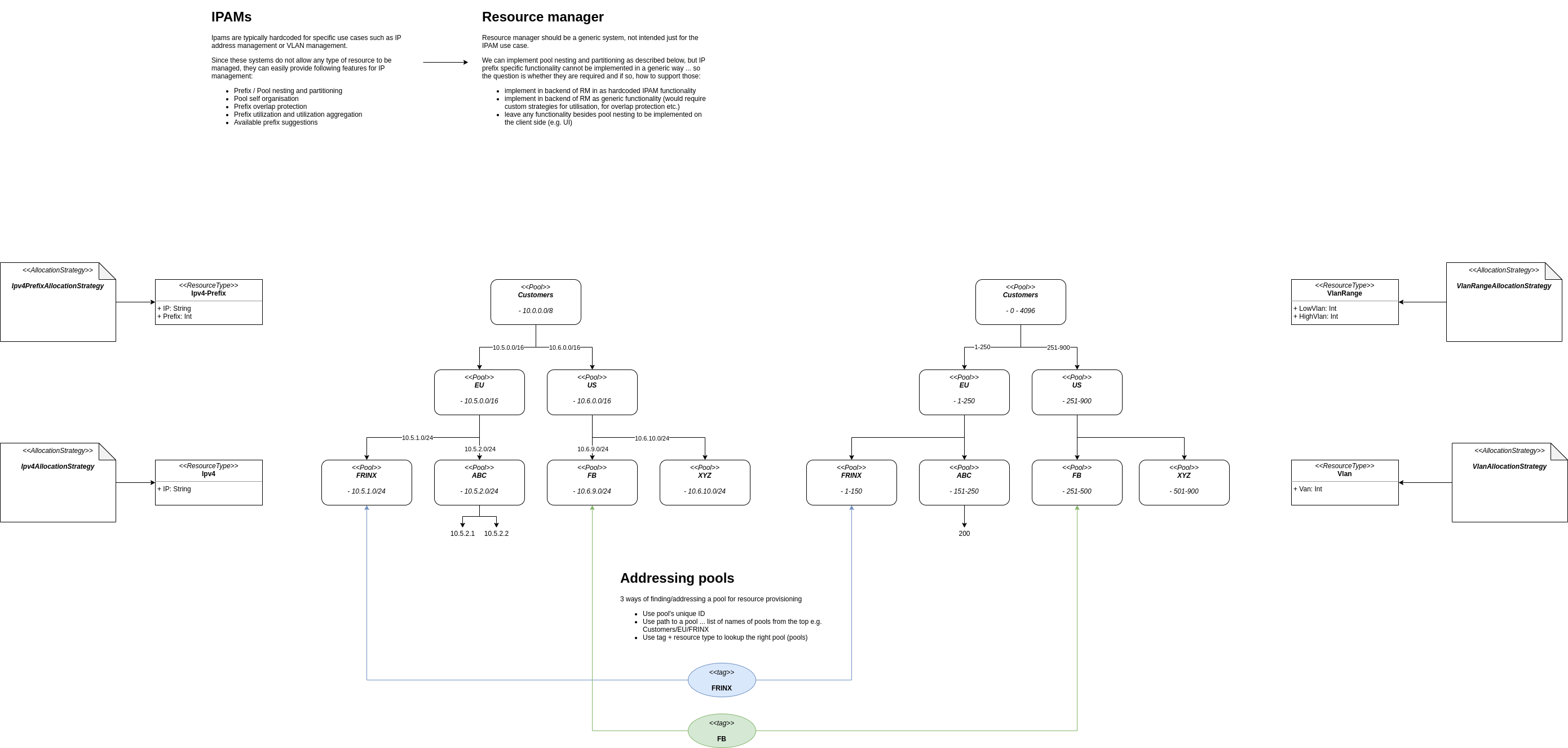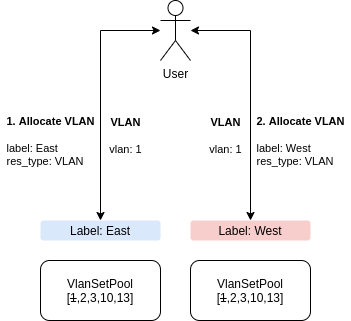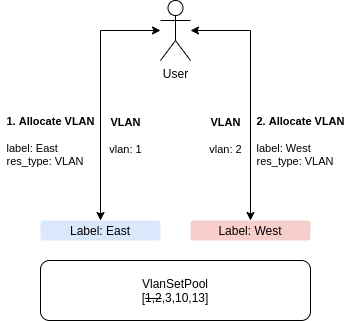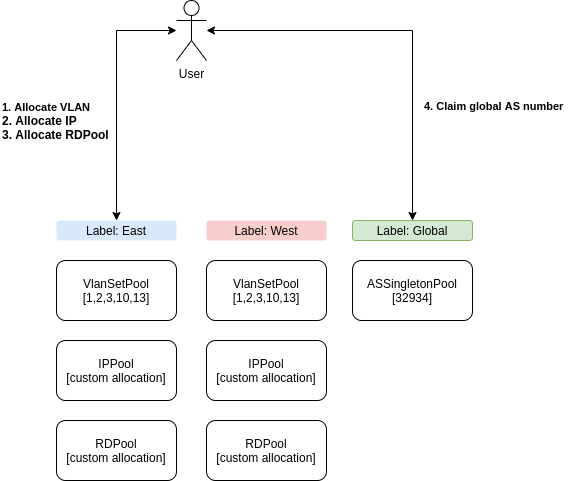#
Pools
A resource pool is an entity that allocates and deallocates resources for a single specific resource type. Resource pools are completely isolated from each other and there can be multiple resource pools for the same resource type even providing the same resource instances. Resource pools encapsulate the allocation logic and keep track of allocated resources. A pool instance should manage resources within the same network or logical network part (e.g. subnet, datacenter, region or the entire, global network).
Example pools:
- IPv4 address pool allocating IP addresses from a range / subnet
- VLAN pool allocating all available VLAN numbers 0 - 4096
- Route distinguisher pool allocating route distinguishers from a specific, per customer, input
Depending on resource type and user’s requirements, pools need to be capable of allocating resources based on various criteria / algorithms. Currently, following pool types are supported by Resource Manager:
#
SetPool
Pool with statically allocated resources. Users have to define all the resources to be served in advance. The pool just provides one after another until each resource is in use.
This type of pool is suitable for cases where a set of resources to be served already exists.
Properties of SetPool
- Config
- Set of unique resources to provide
- Name of the pool
- Resource recycling - whether deallocated resources should be used again
- Operational
- Utilisation - % of pool capacity used
#
SingletonPool
SingletonPool serves just a single resource for every request.
This type of pool can be utilized in special uses cases such as serving a globally unique single AS number of an ISP. Instead of hardcoding the AS number as a constant in e.g. workflows, it can be “managed” and stored in the Resource Manager.
Properties of SingletonPool
- Config
- A single unique resources to provide
- Name of the pool
#
AllocatingPool
AllocatingPool is a type of pool that enables algorithmical resource allocation. Instead of using a pre-allocated set of resources to simply distribute, it can create resources whenever asked for a new resource. This type of pool allows users to define a custom allocation logic, attach it to the pool and have use-case specific resource allocations available. Important feature of this pool type is the ability to accept new allocation logic from users in the form of a script without having to rebuild the Resource Manager in any way.
This type of pool can be used when
- a predefined set of resources cannot be used
- resource creation requires additional inputs
- or in general whenever using an allocation script makes more sense then using a predefined set of resources
Properties of AllocatingPool
- Config
- Allocation strategy - a script defining the allocation logic
- Name of the pool
- Resource recycling - whether deallocated resources should be used again
- Limit - hard limit on total number of resource that can be produced
- Operational
- Utilisation - % of pool limit used
Example AllocationPools:
- Pool providing all available VLAN numbers
- Pool providing just odd VLAN numbers
- Pool providing random VLAN numbers
- Pool providing Route Distinguishers that include customer specific information (which is passed as “additional input” as part of resource claim request)
- Pool providing IPv4-mapped IPv6 addresses from a specific range / subnet
- In general, anything that a user might need
#
Nested pool
Resource Manager allows to create nested pools. Nested pools provide possibility to create subgroups from already existing pools. With these subgroups it is easier to reason about topology.
#
How to create nested pool
Process (in UI):
- Create pool or open existing one
- Allocate resource in newly created or existing pool
- Open create pool page
- Select parent from which nested pool should be created
- Select allocated resource of parent from which nested pool will be taking resources
- Fill other mandatory inputs
- Push button to create nested pool
After successful submit newly created nested pool should be visible in pools list or in nested pools list in its parent detail page. Also it is possible to create nested pool from detail page of pool.
#
Allocation strategy overview
Allocation strategy encapsulates the allocation logic and is always tied to (an) instance(s) of AllocatingPool. The strategy is defined in form of a script using Javascript (or similar) language and its responsibility is:
To produce a new (unique) resource instance based on a set of previously allocated resources and any additional, user submitted input.
Apart from a resource being unique, there are no other requirements on what the strategy needs to do. It gives users the freedom to implement any logic.
Allocation strategy can take any input provided in a structure named userInput. This input is provided by the user every time they claim a new resource.
Allocation strategy also gets access to a list of already allocated resources and any properties associated with the pool being utilized.
#
Pool hierarchies
Resource Manager allows pools to be organized into hierarchies e.g.

#
Labels
Labels enhance resource management by allowing a pool to be marked with a custom string. Multiple pools can have the same label forming a logical group of pools.
A group of pools under the same label can be dedicated to some logical part of a network (e.g. datacenter, subnet, region etc.).
A single pool should typically have only one label i.e. it should not be re-used across unrelated networks.
The following diagrams represent some of the configurations that can be achieved using Labels:
#
Configuration: Pool instance per Label
Enables: Resource reuse in multiple networks

#
Configuration: Pool instance under multiple labels
Enables: Unique resources across different networks

#
Configuration: Pool grouping
Enables: Dividing resource pools into groups based on network regions. Enables users to simply ask for a resource based on label name + resource type (removing the need to know specific pools)

#
Configuration: Multiple pool instances under the same Label
Enables: Resource pool expansion in case an existing pool runs out of resources. Serves as an alternative to existing pool reconfiguration. If multiple pools of the same type are grouped under the same label, the pools are drained of resources in the order they have been added to this group/label.

